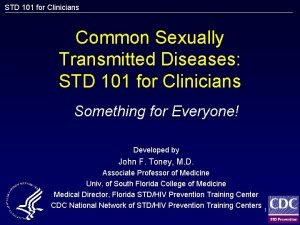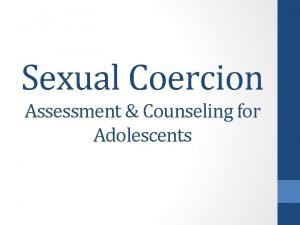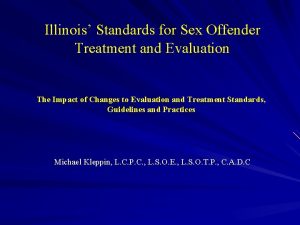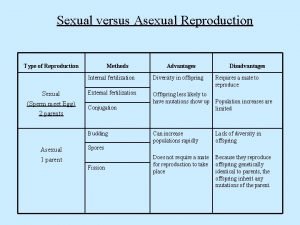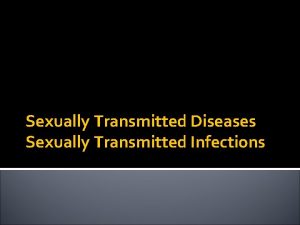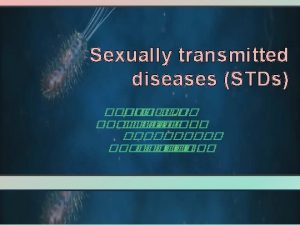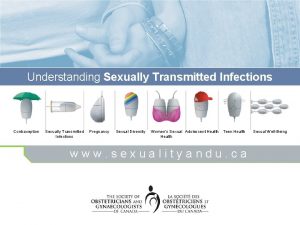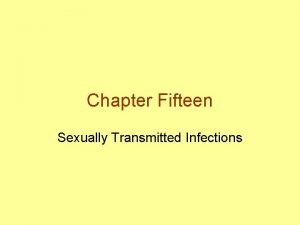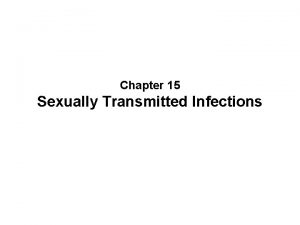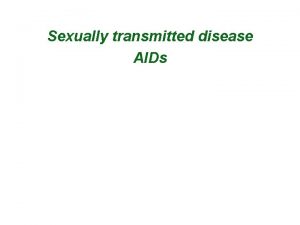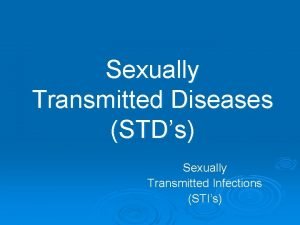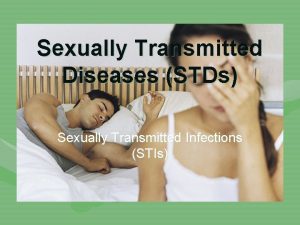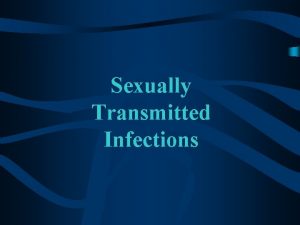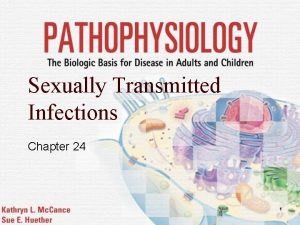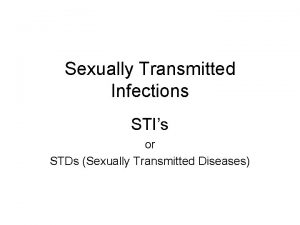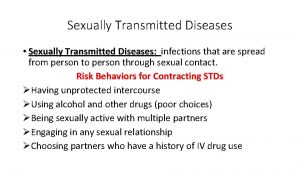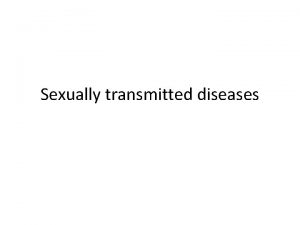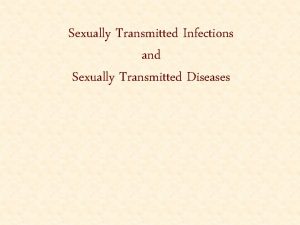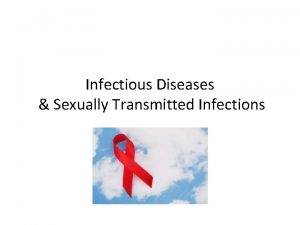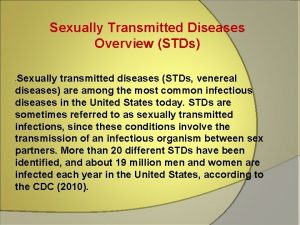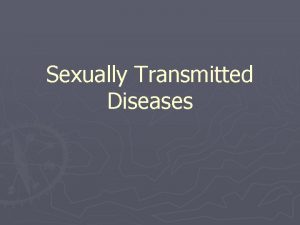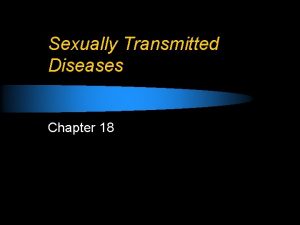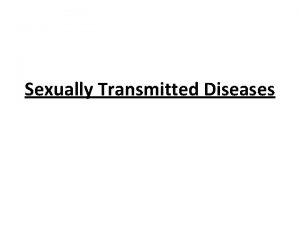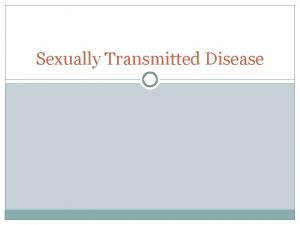Sexually Transmitted Infections TOP WAYS TO CONTRACT AN














































- Slides: 46

Sexually Transmitted Infections


TOP WAYS TO CONTRACT AN STD • Sexual activity at a young age. The younger a person starts having sex, the greater his or her chances of becoming infected with an STD. • Lots of sex partners. People who have sexual contact — not just intercourse, but any form of intimate activity — with many different partners are more at risk than those who stay with the same partner.

If you don’t have… Unprotected sex. Latex condoms are the only form of birth control that reduce your risk of getting an STD. Spermicides, diaphragms, and other birth control methods may help prevent pregnancy, but they don't protect a person against STDs. • The importance of seatbelt safety!

Alarming Statistics Click


What is a Sexually Transmitted Infection? • Infections you can get by having sex – vaginal, or anal – with someone who is already infected. • Caused by bacteria or viruses that are spread through blood, semen, and vaginal fluids. • Also, spread simply by touching infected skin for certain STIs, like herpes and genital warts.

Types of STIs • Bacterial Ø Syphilis Ø Gonorrhea Ø Chlamydia • Parasitic Ø Pubic Lice Ø Scabies • Viral Ø Ø Ø Genital Herpes Human Papilloma Virus (Genital Warts) Molluscum Contagiosum Hepatitis B &C HIV

Syphilis • Bacterial STI • 36, 000 cases in 2006 • Called the “Great Imitator” because so many of the signs and symptoms are indistinguishable from those of other diseases • Passed from person to person through direct contact with a syphilis sore

Signs/Symptoms Primary Stage - Appearance of a typically painless, single sore (chancre) - Usually appears about 3 weeks after becoming infected

Signs/Symptoms Secondary Stage - Non-itchy skin rash and - Common symptoms include sore throat, fatigue, headache, and swollen lymph glands - Less frequent symptoms include fever, aches, weight loss, hair loss, aching joints, or lesions (sores) in the mouth or genital area

Signs/Symptoms Latent Stage - No symptoms, but infection is still there Tertiary (Late) Stage - Mental illness, blindness, deafness, memory loss or other neurological problems, heart disease, and death

Treatment A single intramuscular injection of penicillin, an antibiotic, will cure a person who has had syphilis for less than a year

Gonorrhea • Bacterial STI • Caused by bacteria called Neisseria gonorrhoeae • Estimated that 700, 000 people acquire each year, but half do not report • Spread through contact with the penis, vagina, mouth, or anus

Signs/Symptoms • May take between 2 and 5 days to show • Burning sensation when urinating • White, yellow, or green discharge from the penis • Painful or swollen testicles • Increased vaginal discharge, or vaginal bleeding between periods

If not treated…. Pelvic Inflammatory Disease Epididymitis

Treatment • Several antibiotics can successfully cure gonorrhea in adolescents and adults • Gonorrhea is becoming more difficult to cure because of the growing resistance to antibiotics

Chlamydia • Bacterial STI • Most frequently reported bacterial sexually transmitted infection in the United States • Known as a "silent" disease because about three quarters of infected women and about half of infected men have no symptoms • Transmitted through vaginal, anal, or oral sex

Signs/Symptoms • If there are symptoms, they occur within 1 to 3 weeks after exposure • Abnormal discharge or a burning sensation when urinating • Burning and itching around the opening of the penis • Lower abdominal pain and low back pain • Nausea, fever, pain during intercourse

Treatment • Easily treated and cured with antibiotics (azithromycin or doxycycline) • If not treated, it can lead to conditions, such as pelvic inflammatory disease (PID)

Pubic Lice (Crabs) • Parasitic STI • Small, six-legged creatures that invade the genital hair region and infest it with their eggs • Can be spread through sexual contact or by contact with an individual’s linens or clothing

Pubic Lice

Signs/Symptoms • Itching in the genital area • Visible nits (lice eggs) or crawling lice • Genital lesions due to bites • Lesions caused by constant scratching

Treatment • Can be cured! • Wash thoroughly • Use an over-thecounter or prescription medication - Lice-killing shampoos (pediculicide)

Scabies • Parasitic STI • Contagious, itchy skin condition caused by very small, wingless insects or mites • Found in the crevices of the body such as the armpits, around the nipples for women, beneath nails, belt line, between the fingers, buttocks, elbows, inner thighs, on the penis for men, skin under rings, bracelets or watch bands, wrists

Scabies

Signs/Symptoms • Itching, especially at night • Pimple-like irritations, burrows, or rashes of the skin • Abrasions of the skin from scratching and digging

Treatment • Can be cured! • Prescription creams and lotions • Cool soaks and calamine lotion

Genital Herpes • Viral STI – - Herpes Simplex virus type 1 (HSV-1) * causes cold sores and blisters - Herpes Simplex virus type 2 (HSV-2) * causes genital herpes • At least 45 million people ages 12 and older have it in the U. S. • Transmitted through sexual/intimate contact with an individual who has genital herpes

Signs/Symptoms • First outbreak usually occurs within two weeks after the virus is transmitted, and the sores typically heal within two to four weeks • May include a second crop of sores, and flu-like symptoms, including fever and swollen glands • Blisters that can break and become painful, tender ulcers • Diagnosed by taking a sample from a sore and testing it in a laboratory

Herpes Can Also Be on Other Parts of the Body…

Treatment • No treatment that can cure herpes, but antiviral medications can shorten and prevent outbreaks during the period of time the person takes the medication • This one is for life!

Human Papilloma Virus (HPV) “Genital Warts” • Viral STI • Approximately 20 million people are currently infected with HPV • 100 different strands, more than 30 of these viruses are sexually transmitted

Signs/Symptoms • Most people who have a genital HPV infection do not know they are infected • Genital warts usually appear as soft, moist, pink, or flesh-colored swellings, usually in the genital area • Linked to cervical cancer

Genital Warts In some cases, warts can grow quickly into irregularly shaped cauliflower-like masses

Diagnosis • Pap tests (primary cancer-screening tool for cervical cancer or precancerous changes in the cervix) • Observing the warts (sometimes cannot be seen)

Connections to Cancer Each year… • 12, 000 women get cervical cancer in the U. S. • 3, 700 women get vulvar cancer • 1, 000 women get vaginal cancer • 1, 000 men get penile cancer • 2, 700 women and 1, 700 men get anal cancer • 2, 300 women and 9, 000 men get head and neck cancers

Treatment • No cure for genital warts • In some cases, the infection will clear on its own • Vaccine (Gardasil)

Molluscum Contagiosum • Mild, but common viral skin disease • Touching or scratching a bump and then touching another part of the body • Can be spread through sexual or intimate contact

Molluscum Contagiosum • Small white, pink, or flesh-colored bumps or growths with a dimple or pit in the center • Normally disappear within 6 to 12 months without treatment

Hepatitis (B & C) • Viral STI • Transmitted through the exchange of fluids during sexual intercourse • Approximately 750, 000 people in the United States are living with sexually acquired hepatitis B infection • CDC estimates that nearly 4 million Americans are infected with Hepatitis C

Signs/Symptoms • • Jaundice Fatigue Abdominal pain Loss of appetite Nausea, vomiting Joint pain Damage to the liver

Treatment • Vaccine for Hepatitis B but not for C • Antiviral medication

• Are you showing signs of a STI? • Are you sexually active? Specifically, are you using protection? No! You must request STI testing.

Talking about STIs is tough. Nassau County Health Department Getting one is even tougher. STI Testing & Treatment If you’re going to have sex, talk 516 -227 -9439 with your partner about prevention BEFORE the act. Planned Parenthood If you don’t know your status, 516 -750 -2500 Get Tested!

PRACTICE SAFE SEX!
 Chapter 25 sexually transmitted infections and hiv/aids
Chapter 25 sexually transmitted infections and hiv/aids Sexually transmitted diseases
Sexually transmitted diseases Chapter 24 lesson 1 sexually transmitted diseases
Chapter 24 lesson 1 sexually transmitted diseases Sexually transmitted disease
Sexually transmitted disease Chapter 24 sexually transmitted diseases and hiv/aids
Chapter 24 sexually transmitted diseases and hiv/aids Sexually transmitted diseases
Sexually transmitted diseases Gods ways are not our ways
Gods ways are not our ways Contingent contract and wagering contract
Contingent contract and wagering contract Ifrs 15
Ifrs 15 Retroviruses and opportunistic infections
Retroviruses and opportunistic infections Opportunistic infections
Opportunistic infections Classification of acute gingival infections
Classification of acute gingival infections Infections opportunistes digestives
Infections opportunistes digestives Genital infections
Genital infections Understanding the mirai botnet
Understanding the mirai botnet Eye infections
Eye infections Opportunistic infections
Opportunistic infections Genital infections
Genital infections Storch infections
Storch infections Postpartum infections
Postpartum infections Can methotrexate cause yeast infections
Can methotrexate cause yeast infections Salmonella life cycle
Salmonella life cycle Bone and joint infections
Bone and joint infections Storch infections
Storch infections Spongia officinalis
Spongia officinalis Vasocongestion definition
Vasocongestion definition Do flatback sea turtles reproduce sexually or asexually
Do flatback sea turtles reproduce sexually or asexually Run away selection
Run away selection Child abuse quiz
Child abuse quiz How to birds mate
How to birds mate How do annelids reproduce
How do annelids reproduce How do whales reproduce sexually
How do whales reproduce sexually Cnidaria
Cnidaria What is coercion
What is coercion Sand dollar aristotle's lantern
Sand dollar aristotle's lantern Dimorphism meaning
Dimorphism meaning Was i sexually harassed quiz
Was i sexually harassed quiz Platyhelminthes ecological role
Platyhelminthes ecological role Frustrated shipping
Frustrated shipping Reproduction in protists
Reproduction in protists Is phytoplankton a protist
Is phytoplankton a protist Sexually dangerous persons act illinois
Sexually dangerous persons act illinois Sexual propagation
Sexual propagation Spider phylum
Spider phylum Oblique light examination in questioned document
Oblique light examination in questioned document Electronically transmitted postal ballot system
Electronically transmitted postal ballot system The totality of learned socially transmitted behavior
The totality of learned socially transmitted behavior



